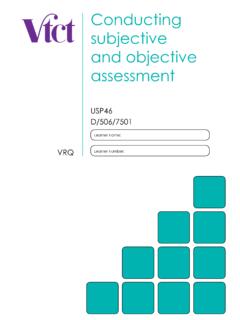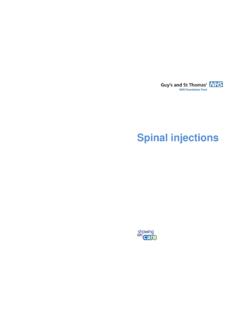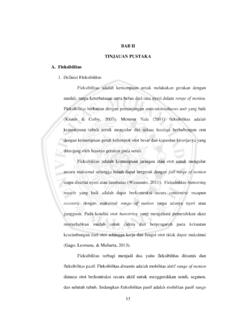Transcription of Evaluation and Treatment of Sacral Somatic Dysfunction
1 Diagnosis and Treatment of Sacral Somatic Dysfunction , with Indirect,Directand HVLA Techniques(Counterstrainand Muscle Energy) Evaluation and Treatment of Sacral Somatic DysfunctionF. P Wedel, Adjunct Professor in Osteopathic Principles and Still University School of Osteopathic Medicine in ArizonaLearning Objectives Review the following diagnostic and Treatment techniques related to Sacral Somatic Dysfunction : Lumbosacralspring test Sacral palpation Respiratory motion test Seated flexion test Sacral Somatic dysfunctions see table Clinical presentations applicable to Sacral diagnosis and Treatment Techniques for Sacral Somatic dysfunctionSacral Techniques , indirect, respiratory cooperation, for bilateral , direct, muscle energy, for bilateral flexion , direct, respiratory cooperation, for bilateral extension -Supine, indirect, respiratory cooperation, for bilateral extension-Prone, direct, LVMA.
2 For Sacral rotation on same axis (anterior torsions) , direct, muscle energy, for Sacral rotation on same axis (anterior torsions)-Prone, direct, LVMA, for unilateral flexion (shear) -Prone, direct, LVMA, for unilateral extension (shear) 5. HVLA for Anterior and Posterior Sacral torsionsSacral Clinical Presentations Presentations commonly associated with Sacral Somatic Dysfunction and/or benefiting from correction of that Dysfunction : Low back pain traumatic history Status Post Labor History of difficult labor Constipation Menstrual cramps / Dysfunction Prostate dysfunctionBACKGROUNDSACRAL STRUCTURE,LIGAMENTS AND MUSCLESTHE SACRUMM eans sacred because of its density it is the last bone to decay and because it protects the reproductive systemForces on the sacrum Angle of the sacroiliac joint wedges the sacrum in an anterior direction Prevents posterior movement Dorsal (posterior)
3 sacroiliac ligaments much stronger than anterior sacroiliac ligaments Purpose: counteract significant pelvic forces pushing apex posteriorly. Major Pelvic Ligaments Iliolumbar from iliato 5thlumbar vertebrae Sacrospinous Sacrum to spine of the ischium Sacrotuberous Sacrum to ischialtuberosity sacroiliac Ligament Covers much of the sacroiliac joint , ant & postIliolumbar ligamentsStabilizes the 5th (4th) Lumbar vertebrae to the iliaWedging of the sacrum creates an anterior forceIliolumbar ligSacrospinousSacrotuberous Ligament Runs from lower Sacral tubercles to ischial tuberosity Gluteus maximus attachment Tendon of the biceps femoris attachment Connects with fascia of the pelvis from sacrum to ischialtuberosity stabilizes anterior motionSacrospinous ligamentSacrotuberousligamentBoth Sacrospinous& Sacrotuberousstabilize to prevent posterior - superior rotation of the Sacral apex around a transverse
4 AxisSacroiliac Ligament sacroiliac actually three ligaments Anterior or ventral sacroiliac from 3rd Sacral segment to lateral preauricular sulcus interosseoussacroiliac massive bond between the upper parts of the joint dorsal sacroiliac Partly covers the interosseous, from lateral Sacral crest to PSIS and internal iliac SacroiliacSacroiliacLigamentinterosseous Posterior sacroiliacPelvic muscle attachmentsfrom above. Posterior Muscular Attachments Attach to Sacrum Erector Spinae Iliocostalis Longissimus Erector Spinae Multifidus Attach to Innominates Obliques(internal, external, transverse) QuadratusLumborumPosterior MusclesIliocostalisLongissimusErector Spinae(sacrospinalis)Terminal Attachment of the Spinal DuraS1S2S3S4S5 Multiple axes of motion.
5 Transverse (3) Superior S1 Middle S2 Inferior S3 Vertical (sagittal) A/P Oblique (2) Left RightSacral AxesSacral AxesSACRAL ANATOMICAL AXISSACRAL ANATOMICAL AXISSACRAL ANATOMICAL AXISSACRAL ANATOMICAL AXIST ransverse axis Superior: the cranial&primary respiratory mechanism creates motion around this axis Middle: Sacral base anterior and posterior (FB/BB) occur around this axis Inferior: the innominates rotate around this axisSACRAL PHYSIOLOGIC AXISSACRAL PHYSIOLOGIC AXISSACRAL PHYSIOLOGIC AXISSACRAL PHYSIOLOGIC AXIS Oblique: both leftand rightoblique axes are named for the superior pole Sagittal: includes both mid-sagittal and an infinite number of parasagittal axes Horizontal: functional axis of Sacral flexion/extension occur around this axis (analogous to the middle transverse axis above)(footnote on functional anatomy)Why are the Oblique Axes so significant?
6 They are the Axes of walking cycle as it applies to our discussion1. From a standing (neutral) position, when you take a step forward, your weight is shifted onto one lower This induces spinal column SB to the weight bearing side, and pins the upper pole of the sacrum on the side of the As the free lower extremity swings forward, it carries the free pole of the sacrum anterior, creating rotation of the sacrum about theOblique Axis, towards the weight bearing Line: You form Oblique Axes with every step you take!
7 Ex.:RLon LOARRon ROATESTSTo make a Sacral Diagnosis you will need to know the following: Static (Pure) Landmarks Sacral base -Ant/ Post ILA -Ant/Post ASIS & PSIS Mixed Landmarks Sacral Sulcus -Deep/Shallow STL -Tight/ Loose/ Equal Motion Testing Spring test L5 Sacrum Record Positive Right, Positive Left, or Negative TestMost of those pieces we have discussed, There is one that we have not talked much about Spring Test. It s purpose: To be an indicator of whether you are dealing with a Sacral Oblique Axis that is Torsion(Neutral) or Backward Torsion(Non-Neutral).
8 Spring TestSpring TestSpring TestSpring Test1. Find Sacral base2. Place heel of hand over Lumbosacral junction3. Spring in an Anterior motion4. Results:a. Positive test= If there is NOspringing allowed = Non-neutralcondition(AKA Backward torsion)b. Negative test= If there is springing allowed = LandmarksSacral Base Judge whether the tip of the thumb is more anterior on one side than the tip of the thumb on the other side. Can also bring index fingers over onto Sacral base and take measurement on the lateralized side.
9 Record which base is anterior. Sacral Sulcus Depth Palpable groove just medial to PSIS. Space between Sacral spines and lateral Sacral crest. Place thumbs in inferior border of PSIS. Move -1 up and medial to PSIS. Push thumb tips on Sacral base. Pads of thumbs are on iliumand tips on Sacral base. Measure the depth of each Sacral sulcus relative to opposite sulcus? Record even, deep, or shallow, comparing one side to the other. Both sides may be shallow or deep as Lateral Angle 1. Place flat of hand over sacrum near its caudal end and identify the coccyx.
10 2. Thumbs approximately 1 apart. Place thumbs in glutealarea about 1 caudal and on each side of coccyx. 3. Push thumbs cephaladuntil pads rest on inferior margin of ILA. Take a reading on the lateralized side: Inferior or superior? Possibly even? 4. Move thumbs approximately 1 cephaladfrom the inferior margin of the ILAsand place the pads of the thumbs over the posterior surface of the ILAsnear the apex of the sacrum. 5. Use moderate equal pressure & judge if one side is more anterior or posterior than the other one or are they equal?







